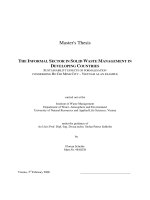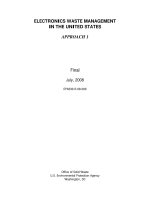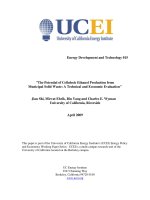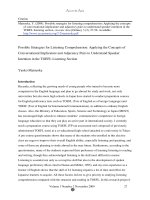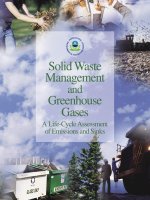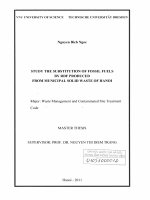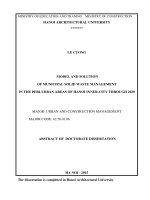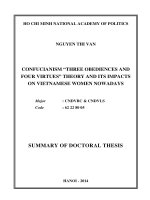MODEL AND SOLUTION OF MUNICIPAL SOLID WASTE MANAGEMENT IN THE PERI-URBAN AREAS OF HA NOI INNER-CITY THROUGH 2030
Bạn đang xem bản rút gọn của tài liệu. Xem và tải ngay bản đầy đủ của tài liệu tại đây (827.7 KB, 27 trang )
MINISTRY OF EDUCATION AND TRANING MINISTRY OF CONSTRUCTION
HANOI ARCHITECTURAL UNIVERSITY
*******
LE CUONG
MODEL AND SOLUTION
OF MUNICIPAL SOLID WASTE MANAGEMENT
IN THE PERI-URBAN AREAS OF HANOI INNER-CITY THROUGH 2030
MAJOR: URBAN AND CONSTRUCTION MANAGEMENT
MAJOR CODE: 62.58.01.06
ABSTRACT OF DOCTORATE DISSERTATION
HA NOI - 2015
The dissertation is completed in Hanoi Architectural University
Dissertation Supervisors: 1. Hoang Van Hue, Prof., Ph.D
2. Cu Huy Dau, Assoc. Prof., Ph.D
Referee 1: Nguyen Hong Tien, Assoc. Prof., Ph.D
Referee 2: Nguyen Lan, Prof., Ph.D
Referee 3: Tran Thi Huong, Assoc. Prof., Ph.D
The oral defense of this dissertation before the Doctorate Board was held:
At hour day month year 2015
The dissertation can be found at the National Library or at the Library of Hanoi
Architectural University
1
INTRODUCTION
1. The necessity of the dissertation subject
Currently, Hanoi City generates about 6,500 tonnes of municipal solid waste
(MSW) per day, of which the amount of solid waste generated from 12 urban districts
of about 3800 tons, from the suburban area district (District 9) is about 1110 tons; The
remaining solid waste is generated from the remaining districts [3], [73].
The process of urbanization, expansion and development of Hanoi City has a
strong impact on the socio-economic conditions, infrastructure of peri-urban areas.
The creation of new districts, villages turned into wards and peri-urban areas fluctuate
by the urban management policies and administrative measures. Poor infrastructure,
solid waste management in peri-urban areas is inadequate; waste collection,
transportation and disposal services of Urban Environment Company (URENCO)
does not reach far areas.
In many rural areas, the garbage collection model by self-governing citizens
has formed. However, only few models operate effectively. In suburban areas, where
the urbanization process developed rapidly, if the waste is not managed well cause
environmental pollution [22]. Therefore the subject "Model and solution of
municipal solid waste management in the peri-urban areas of Hanoi inner-city
through 2030" is necessary.
2. Purposes of the research
- Improving the efficiency of state management in the MSW collection,
transportation and disposal services in peri-urban areas of Hanoi inner-city.
- Building a model and solution of MSW management of in the peri-urban
areas of Hanoi inner-city relevant to the planning of solid waste management of Hanoi
through 2030.
3. Object and scope of the research
3.1. Object of the research: Municipal solid waste; Industrial solid waste and
trade villages belonging to other research.
3.2. Scope of the research: 9 suburban districts which have the administrative
boundaries adjacent to the urban districts of Hanoi as planned through 2030.
4. Research method and approach
(1) Investigation method; (2) Synthesis and analysis methods used in Planning;
(3) Inheritance method; (4) Comparison and control method; (5) Expert opinion
method.
This dissertation approaches in suburban areas which are in the "Moving" status,
2
always changing in the process of urbanization and expansion of the City.
5. The science, practice significance and new contributions of the
dissertation
5.1. The science and practice significance of the dissertation
a. The science significance
Using scientific arguments, dissertation was to clarify the concept of peri-urban
areas, building a theoretical and practical basis on which a model and solution of
MSW management in peri-urban areas of Hanoi through 2030 is proposed.
b. The practice significance
Dissertation contributes to the implementation of the Solid waste disposal
planning of Hanoi through 2030, with orientations toward 2050.
5.2. New contributions of the dissertation
1. The dissertation was to clarify the concept of peri-urban areas, the difference
between the peri-urban areas and suburb areas, factors affecting MSW management
in peri-urban areas.
2. Propose a model of organizational structure of URENCO in districts,
environment service cooperatives, self-governing sanitation teams; clarify the
responsibilities and duties of the concerned organisations and individuals.
3. Propose a general model of MSW disposal in nine suburban districts;
determine the location, size, capacity and processing technology of solid waste
treatment facilities in suburban areas for suburban districts planned with or without
MSW disposal facilities.
4. Propose three models of MSW management: (1) MSW is collected and
sorted at the source and transported to the final disposal; (2) The MSW management
model for residential areas in urbanization towns and communes; (3) The MSW
management model for residential areas of agricultural communes; The process of
collecting, sorting, transport and disposal of MSW in the peri-urban areas of Hanoi
inner-city through 2030.
5. Propose mechanisms and policies for socialization of MSW management
services in the peri-urban areas of Hanoi inner-city.
6. Some scientific concepts of solid waste and solid waste management
7. The structure of the dissertation
In addition to the appendix, references the content of the dissertation consists
of three main chapters with a total of 158 pages:
3
Prologue (9 pages);
Chapter 1. Overview of MSW management in urban and peri-urban areas (60
pages);
Chapter 2. Science and practice basis of the dissertation (37 pages);
Chapter 3. Proposed model and solution of solid waste management in the
peri-urban areas of Hanoi inner-city through 2030, with orientations toward 2050 (48
pages);
Conclusion and Recommendation (4 pages)
Chapter 1. OVERVIEW OF MSW MANAGEMENT IN URBAN AND
PERI-URBAN AREAS
1.1. Suburban areas and peri-urban areas
1.1.1. The concept of suburban and peri-urban areas
a. Inner city and suburbs
Hanoi is the Capital City which has district-level administrative units including
districts, towns. The inner city consists of inner districts which include of wards. The
the suburbs consists of outer districts which include of communes and towns [5].
b. Peri-urban areas
It can be seen that there are differences in interpretation and definition of peri-
urban areas. But in the majority of cases, peri-urban areas are considered including all
communes, towns territory near or even adjacent to the inner city area is specified via
the administrative measures [30],[41].
1.1.2. The difference between suburban and peri-urban areas
Peri-urban areas belong to the suburb and are close to the inner districts.
1.2. The process of formation and development of peri-urban areas of
Hanoi inner-city
1.2.1. The formation and development of the districts of Hanoi
* The period 1954-1994: Before 1995, Hanoi has only 4 inner districts.
* So far: Hanoi has 12 inner districts, 01 towns and 17 outer districts.
1.2.2. Peri-urban areas of Hanoi inner-city through 2030
a. Peri-urban areas of Hanoi inner-city through 2030: All communes and towns
in nine districts (Dan Phuong, Hoai Duc, Thanh Oai, Thanh Tri, Thuong Tin, Gia
Lam, Dong Anh, Chuong My and Me Linh) near or adjacent to the 12 inner districts
of Hanoi.
4
Figure 1.1. Center urban
and suburban areas of
Hanoi city in the period
2014 – 2030 (the period of
the inner city of Hanoi has
12 counties) [54] (photo
by the dissertation author)
b. Peri-urban areas of Hanoi inner-city expected for the period 2030 – 2050
To determine the peri-urban areas should be based on time and planning stage.
Review and assessment: During the development and expansion of Hanoi City,
along with the creation of new districts, Peri-urban areas will always be in “moving”
status.
1.3. The basic characteristics of the peri-urban areas - Classification of
peri-urban residential areas
1.3. The basic characteristics of the peri-urban areas
- Economy: Unlike rural areas, peri-urban areas include a more comprehensive
economic activity.
- Social: In peri-urban area, population composition is inhomogeneous,
educational level and awareness of people is higher than in rural areas. Social
relationships are more complex and more multidimensional. The variability of the
peri-urban area is very large, there are a lot of people moving from rural areas to
urban and peri-urban areas. Careers changing trends to services, handicraft, because of
reduction of agricultural land.
- Environment is polluted, infrastructure is overloaded and rapidly degraded.
1.3.2. Classification of peri-urban residential areas
In the study area, there are 183 towns and 12 communes with a total of 733
5
residential areas: 462 agricultural residential areas; 180 service residential areas and
91 residential areas of trade village.
1.4. Current status of MSW management in urban and peri-urban areas in
some countries in the world
a. Developed countries: Japan, Singapore.
b. Developing countries: Thailand, The Philippines.
c. Review and assessment:
In developed countries: The legal system is perfect and well-enforced;
Synchronous infrastructure system, modern technology create favorable conditions for
the collection and disposal of waste; The process of collection, transport and disposal
of MSW is reasonable; Sorting waste at sources is highly focused and well
implemented, thereby promotes reuse thoroughly, reduces the volume of waste sent
for processing; Share responsibilities and obligations between the State - Business -
People; Reasonable service fee.
In developing countries (Thailand, The Philippines, Malaysia): The collection,
sorting at sources of MSW is well implemented; Recycling of MSW is well
developed.
1.5. Current status of MSW management in urban and peri-urban areas in
some cities in Vietnam
1.5.1. MSW management in urban and peri-urban areas in Ho Chi Minh City
In addition to the formal system (CITENCO, other public service companis)
that controls urban solid waste managemen, the non-formal system established by the
residentials responsible for the collection of solid waste, including individuals, 30
enterprises and 05 cooperative unions. The rate of collection and transportation of
solid waste between the private sector and the state is 40% and 60%; MSW disposal is
mainly undertake by private companies.
1.5.2. MSW management in urban and peri-urban areas in Danang City
Currently, Danang Urban Environment Company collected an average of 574
tons of solid waste per day, nearly about 88% of the amount of waste generated.
1.5.3. MSW management in urban and peri-urban areas in Haiphong City
Currently, most of the suburban districts of Haiphong City do not have
concentrate waste disposal facilities (except for Gia Minh waste disposal area in Thuy
Nguyen District).
1.5.4. Review and assessment
According to statistics of the Department of Infrastructure, Ministry of
6
Construction, as of April 2012, the total amount of MSW generated in the whole
country is over 61,500 tons per day, of which urban MSW accounts for over 50%,
rural areas of less than 50%. In Vietnam, solid waste in urban and peri-urban areas
have yet to be sorted at source; The proportion of solid waste collection in urban areas
is 83%, in rural areas is 30%. Landfill is still MSW disposal forms (accounting for 80-
83% of MSW), secondary compost products (7%), the recovery and recycling of
waste in the private facilities (10-12%). There have not yet been a synchronous
system of collection, transportation and disposal of waste, still lack of waste disposal
facilities at the locals, rural districts.
1.6. Current status of MSW management in urban and peri-urban areas of
Hanoi inner-city
1.6.1. Current status of MSW management in Hanoi City
- Sorting: Only a few of wards, commues develop 3R project.
- Collection and transport: In addition to the Urban Environment Company of
Hanoi City (URENCO) there are (1) URENCOs of Dong Anh, Gia Lam, Soc Son and
Thanh Tri districts; (2) Private enterprises (Thang Long Environment JSC, Thanh
Cong Cooperative, Green Environment); (3) Ha Dong Environment Public Service
JSC, SonTay Urban Construction And Environment JSC. …
- The current status of MSW disposal: landfill, composting, recycling.
1.6.2. Current status of MSW management in the peri-urban areas of Hanoi
inner-city
MSW management in the peri-urban areas of Hanoi inner-city is fully
insufficient in sorting, collection, transport and disposal.
1.6.3. Management mechanisms and policies of MSW of Hanoi City
Management mechanisms and policies of MSW are still some shortcomings
need to be adjusted in the near future. Also, some additional legislation on
socialization of MSW management is needed in order to attracting the private sector
to the collection, transportation and disposal of MSW.
1.7. Some models of socialization of MSW management in Vietnam and in
Hanoi City
1.7.1. Some models of socialization of MSW management in Vietnam [47]
Hanoi and Ho Chi Minh are the two leading cities in socialization of MSW
management. In other localities, there are private enterprises such as Kien An
municipal Administration Compamy, Do Son Public Service Company (Haiphong
City), Cam Pha Industry JSC, An Lac Vien Limited Company (Quang Ning
Province), Huy Hoang Limited Company (Lang Son Province)… In solid waste
7
disposal, there is also the participation of private sector, for exemple SERAPHIN
Company, Tam Sinh Nghia Company. In the whole country, there are 274
environment service co-operatives, of which 154 specialized in environment. Many
enterprises work very effectively, for exemple Thanh Cong Co-operative. …
1.7.2. Some models of socialization of MSW management in Hanoi City
In Hanoi, in addition to the Hanoi URENCO, there are a number of private
companies: Thang Long JSC, Tay Do JSC, Green JSC, Thanh Cong Co-operative…;
self-governing teams in Thanh Tri District, Xuan Mai Environment Service Limited
Company, model in Lai Xa hamlet (Kim Chung commune, Hoai Duc district), model
of solid waste of Van Dinh town (Van Dinh district)…
1.7.3. Evaluate the effectiveness of the MSW management socialization model
The dissertation summarized and used matrix to evaluate the effectiveness of
MSW management socialization models in some localities such as: waste collection
self-governing teams in Yen Lang commune (Vu Thu district, Thai Binh province), in
Nam Cuong commune (Yen Bai city, Yen Bai province) and in Cua Lo Town, Nghe
An province…
1.8. Overview of the related researches
1.8.1. Criteria for selecting the subjects, thesis, dissertations: subjects, new
researches published recently and directly related to the dissertation.
1.8.2. Assess the related scientific researches has been published: The
dissertation presents the results of the study, the problems need for further research.
1.8.3. Comment and assessment: It can be seen, in Vietnam, the research
subjects of the first group are mainly related to technique and technology of solid
waste management; the research subjects of the second and the third groups is mainly
related to the planning of solid waste area or solid waste landfills. There has been no
overall and comprehensive research on MSW management in urban and peri-urban
areas of Hanoi inner-city before the impact of the process of urbanization so far.
1.9. The problems need for further research
- Clarifying the concept of peri-urban areas, suburbs.
- Determine the size, capacity and processing technology of solid waste
treatment areas, solid waste transfer station in peri-urban areas as planned.
- Model and solution of MSW management in the peri-urban areas of Hanoi
inner-city through 2030, with orientations toward 2050.
- Research on the model of management structure and organisation of district
URENCO, environmental service co-operatives and self-government sanitation
8
groups/teams; organic relationship between the units.
- Mechanisms and policies for socialization of MSW management services and
other related problems.
Chapter 1 conclusion
Chapter 2. SCIENCE AND PRACTICE BASIS OF THE OF
MUNICIPAL SOLID WASTE MANAGEMENT IN THE PERI-URBAN
AREAS OF HANOI INNER-CITY THROUGH 2030
2.1. The scientific methodology of solid waste management system
2.1.1. The solid waste management system: is the set of elements or
components that interact with each other in order to protect environment and for
sustainable development.
2.1.2. Type of solid waste management systems in peri-urban areas: district
URENCOs (state-owned of JSC); environmental service co-operatives (if exist); self-
government sanitation groups/teams in communes, towns.
2.1.3. The basic characteristics of solid waste management systems [35]: The
system has boundary, lines between the boundary and the external environment; the
systems change over time (moving status); the systems have hierarchy structure; the
system have dominant.
2.1.4. Structure and organisation of the solid waste management systems
There are three points need to be noticed when considering the structure of the
systems: The target of system must be taken as the standard; Management must be
associated with people in the system. When analyzing the organizational structure of
the solid waste management system should note two levels: Individuals - units, of
which responsibility must be taken as a standards to distinguish; Determine the formal
structure of the systems.
2.1.5. Organizational structure types of solid waste management systems
Organizational structure of functional type; Organizational structure of
management subdivision type; Organizational structure of matrix type.
2.1.6. Limit and responsibility of solid waste management
Thesis determined management limits and responsibilities for the district and
inter-district, the communes and inter-communes which objects managed by
whom
2.1.7. The tools for MSW management
Legislation tools, economic tools, scientific and technology tools; ISO
management, method of integrated management of solid waste in combination with
9
3R, 4R.
2.2. Factors influence the model and solution of MSWmanagement in the
peri-urban areas of Hanoi inner-city
2.2.1 The natural, socio-economic and environmental conditions
- The natural conditions in the peri-urban areas of Hanoi is the natural
conditions of Hanoi.
- Awareness of the people on environmental protection is not high enough, the
backlog and perenniality of waste cause of environmental pollution; The gathering
and disposal areas are temporary.
- Infrastructure systems of the districts in the peri-urban areas of Hanoi are
weak and inadequate; narrow road network makes it difficult for the collection and
transportation of MSW. [59].
2.2.2. Science, technique and technology keep an important role in the
management, but the application of it in management is limited.
2.2.3. The impact from the mechanism conversion from centralized and
administrative - subsidiary economic system to market economic system
Old management method does not meet market mechanisms [78].
2.2.4. MSW management service socialization: MSW management in general
and MSW in peri-urban areas in particular, require the participation of the private
economic sector and mobilization of community participation in the management of
MSW.
2.2.5. Relationship factors between subjects, objects and objectives of the
MSW management
Balance harmoniously the interests, rights of the parties in the MSW
management.
2.2.6. Cooperation in management : Ensuring social welfare, harmonious
interests; Autonomy in coordination with state agencies, units and specialized
organizations.
2.3. The legal basis
2.3.1. The current legislation on the MSW management
Currently, the legal system of MSW management is relatively full and
complete: Law on Environmental Protection of Vietnam 2014, Decree of Government
59/2007/NĐ-CP dated April 09, 2007 on solid waste management, Decision
2149/QD-TTg dated december 17, 2009 of the Prime Minister approving the national
strategy for integrated management of solid waste up to 2025
10
2.3.2. Sustainable development strategy for Vietnam for the period 2011 –
2020
Industrialization and modernization; Urbanization; Population control;
protection of ecological environment.
2.3.3. The national strategy for the integrated management of solid waste
through 2025, with orientations toward 2050 (by Decision 2149/QD-TTg dated
December 17, 2009 of the Prime Minister approving the national strategy for
integrated management of solid waste up to 2025 [53]):
- 04 important goals to the year 2015, 2020 and 2025: (1) Prevention of solid
waste generated; (2) Reduction of solid waste generated; (3) Promote the
classification of solid waste at the sources; (4) Promote the collection, transportation
and disposal of solid waste.
2.3.4. The socialization policy of environmental protection: The MSW
management service is needed to be socialized; promote socialization - preferential
policies for solid waste management socialization.
2.3.5. Overall planning of socio-economic development of Hanoi through 2020,
with orientations toward 2030 (by Decision 1081/QD-TTg dated Jully 06, 2011 of the
Prime Minister approving the master plan on socio-economic development of Hanoi
city through 2020, with orientations toward 2030): Economic restructuring towards
service.
2.3.6. General construction planning of Hanoi through 2030, with orientations
toward 2050 [54]
The center urban will be expanded to the West and to the South to ring road
No.4 and to the North: Me Linh, Dong Anh districts; to the East: Gia Lam and Long
Bien districts.
2.3.7. Orient planning of solid waste management of Hanoi through 2030
As planned, the MSW gathering and disposal system of Hanoi is divided into
three areas, 6 transfer stations (10 ha) and 17 solid waste treatment facilities (430,15
ha).
2.4. The forecast amount of generated MSW in the peri-urban areas of
Hanoi through 2030
By 2030, the population of the nine districts in the peri-urban areas of Hanoi
inner-city will be 2,592,605 people, the total amount of MSW generated will be about
2177.8 tons per day, nearly 2 times the total amount of MSW generated in the peri-
urban areas today.
11
Table 2.2. The forecast amount of MSW generated in the peri-urban areas through
2030
Districts
2010*
through 2030
Population
(people)
W
0
(Kg/peopl
e
/day)
Amount
of MSW
(T/day)
Population
(people)
W
0
(Kg/peopl
e/day)
Amount
of MSW
(T/day)
Dan
Phuong
124900
0,6
74,9
174860
0,84
146,9
Hoai Duc
188800
0,6
113,3
264320
0,84
222,0
Thanh Oai
159600
0,6
95,7
223440
0,84
187,7
Thanh Tri
168000
0,6
100,8
235200
0,84
197,6
Gia Lam
218275
0,6
131,0
305585
0,84
256,7
Dong Anh
321750
0,6
193,0
450450
0,84
378,4
Chuong My
275000
0,6
165,0
385000
0,84
323,4
Me Linh
187536
0,6
112,5
262550
0,84
220,5
Thuong Tin
208000
0,6
124,8
291200
0,84
244,6
Total
1851861
1110,0
2592605
2177,8
Chapter 2 conclusion
Chapter 3. PROPOSE MODEL AND SOLUTION OF SOLID WASTE
MANAGEMENT IN THE PERI-URBAN AREAS OF HANOI INNER-CITY
THROUGH 2030, WITH ORIENTATIONS TOWARD 2050
3.1. The views, goals and principles of solid waste management
3.1.1. The views: Integrated management of MSW in the peri-urban areas of
Hanoi inner-city is the responsibility of the whole society; is one of the priorities of
environmental protection in the suburb areas of Hanoi.
3.1.2. Target to build models: (1) The socio-economic objective; (2) technical
objective; (3) The environmental protection objective.
3.1.3. The principle of building models: In accordance with the spatial
development planning, general planning of solid waste management of the City. In
accordance with the present technical infrastructure conditions and with that in the
future. In accordance with the socio-economic conditions of the localities.
3.2. The model of organizational structure of MSW management in the
peri-urban areas of Hanoi inner-city through 2030
3.2.1. The organizational structure of district URENCO
In total nine districts in the peri-urban areas of Hanoi inner-city, only three
12
districts that have URENCOs (Dong Anh, Gia Lam, Thanh Tri). Therefore, the
remaining six districts needed to establish URENCOs are: Dan Phuong, Hoai Duc
Linh, Chuong My, Thanh Oai and Thuong Tin.
The dissertation presents the organizational and managerial structures,
functions and responsbilities of the district URENCO
3.2.2. Model of the sanitation co-operative
Figure 3.1. The
organizational and
managerial structure
of the sanitation
The city should establish and develop sanitation co-operatives. With this
model, the State does not have to invest capital, facilities, equipment for
manufacturing operations. Besides, this model also helps resolve the problem of idle
labors by attracting them to participate in co-operative activities, creating jobs and
income for them.
3.2.3. The model of self-government sanitation group (team)
Each commune forme a self-government sanitation team; Each village has a
self-government sanitation group; Each group has from 2 to 4 employees, depending
on the specific requirements of each village.
The organizational structure of MSW management of commune is shown in
Figure 3.2.
13
Figure 3.2. The
organizational
and managerial
structure of the
self-
government
sanitation team
3.2.4. Assessment of the organizational structure model of district
URENCO/sanitation co-operative, self-government sanitation group (team)
Along with URENCO system of Hanoi today, the establishment and
development of the system of district URENCO, sanitation co-operative; self-
government sanitation group (team) in peri-urban will be highly effective in terms of
economic - society - environment. They are:
a. On the economic side: enhance the capacity of the district URENCOs. With
the models of the sanitation co-operative and the self-government sanitation group
(team), State does not have to invest capital. Creating jobs will thereby raise incomes
and living standards of the people in the peri-urban areas.
b. On the social side: Raising awareness and responsibility of citizens in
environmental protection; Create unity and consensus of citizens in the peri-urban
areas, contribute to protecting the security and stability of the social order.
c. On the environmental side: Expanding the scope and scale of sanitation
services to all localities in urban areas where now Hanoi URENCO and other
specialized units can not reach; Bringing the solid waste management service to rural
areas in the peri-urban areas of Hanoi, thereby, remove the gap between the
management service of municipal solid waste and solid waste management in rural
areas. Solve the existing problems and shortcomings in the solid waste management in
peri-urban areas today.
3.2.5. The difficulties and challenges when developting the models
In order to establish the district URENCOs, it is necessary to establish effective
management apparatus and to have enough resources (capital, material) to operate;
while the capital resource for the construction of facilities, purchase of machinery and
equipment for the collection, transportation, processing and recycling of solid waste
by URENCOs, including the sanitation co-operatives is not small. This is also a
drawback when we develop the models.
3.3. The general model of MSW disposal in the peri-urban areas of Hanoi
inner-city through 2030
3.3.1. The model of concentrate MSW disposal for the districts that have waste
disposal facilities
Commune People's Committee
Sanitation Team
Sanitation group 1
Sanitation group 2
Sanitation group 3
Population Units
14
As planned, in 9 districts of the peri-urban areas, 5 districts need to adopt the
model of concentrate MSW management with 7 disposal centers in the areas of
concentrate MSW management as planned. These districts are: Dong Anh, Chuong
my, Gia Lam, Thanh Oai, Dan Phuong.
Figure 3.3. MSW disposal
facilities in the peri-urban
areas of Hanoi inner-city
Table 3.1. The size, capacity and processing technology of the concentrate MSW
disposal facilities in the peri-urban areas of Hanoi inner-city
TT
MSW disposal facilities
Capacity
(Tons/day)
Disposal technology
proposed by the dissertation
1
Viet Hung - Dong Anh
district (8,7 ha)
500
- Incinerating;
- Aerobic biological
composting then landfilling
and incinerating.
2
Dong Ke – Chuong My
district (24ha)
500
- Incinerating;
- Aerobic biological
composting then landfilling
and incinerating.
3
Nui Thoong - Chuong
My district (10ha)
500
- Incinerating;
- Aerobic biological
composting then landfilling
and incinerating.
4
Kieu Ky - Gia Lam
district (14ha)
500
- Incinerating;
- Aerobic biological
15
TT
MSW disposal facilities
Capacity
(Tons/day)
Disposal technology
proposed by the dissertation
(closed in 2040)
composting then landfilling
and incinerating.
5
Phu Dong – Gia Lam
district (20 ha)
500
- Incinerating;
- Aerobic biological
composting then landfilling
and incinerating.
6
Cao Duong – Thanh Oai
district (20ha)
500
- Incinerating;
- Aerobic biological
composting then landfilling
and incinerating.
7
Phuong Dinh – Dan
Phuong district (6ha)
500
- Incinerating;
- Aerobic biological
composting then landfilling
and incinerating.
Figure 3.4.
The model of
concentrate
MSW disposal
for the
districts that
have MSW
disposal
facilities as
planned
3.3.2. The model of concentrate MSW disposal for the districts that do not have
MSW disposal facilities as planned
16
Figure 3.5.
The model of
concentrate
MSW disposal
for the
districts that
do not have
solid waste
disposal
facilities, but
transfer
stations as
planned
Figure 3.6.
The MSW
transfer
stations in the
localities of
nine districts
in the peri-
urban areas
of Hanoi
inner-city as
planned
Hoai Duc, Me Linh and Thanh Tri are the districts that have the rapid process
of urbanization, but do not planned MSW disposal facilities. MSW generated from
these districts should be collected and transported to the subdivision MSW transfer
stations and transported for processing in the MSW nearest or Nam Son Waste
17
Sources
Collecting
and sorting
waste at
sources
Gathering,
transport
The final places
Households
Restaurants
Markets,
schools,
offices
Biodegradable
waste
Streets and
public places
Persistent
waste
Recycled
waste
URENCOs
Sanitation
co-operatives
Scrap
collectors
Households
MSW disposal
facilities, transport
stations as planned
Scrap collecting
units
Composting in
households (for
agricultural
communes)
Disposal Complex of the City.
3.3.3. The gathering places, transfer stations of solid waste in the communes
and districts
The network of gathering places, transfer stations of solid waste must be in
accordance with the solid waste treatment planning of Hanoi, the socio-economic
development planning and other development plannings of the districts.
3.4. The model of MSW management in the peri-urban areas of Hanoi
inner-city through 2030
3.4.1. General diagram of MSW management: The management model of
collecting, sorting at source and transporting MSW to final disposal facility.
Figure 3.7. The model of collecting, sorting at source and transporting MSW to final
disposal facility.
3.4.2. Model and solution of MSW management in the peri-urban areas of
Hanoi inner-city through 2030, with orientations toward 2050: (1) The specific model
of MSW management for residential areas of rapid urbanization communes; (2) The
specific model of MSW management for residential areas of agricultural communes.
18
Figure 3.8. The model of MSW management for urbanization towns and
communes in the peri-urban areas of Hanoi inner-city through 2030
Figure 3.9. The model of MSW management for residential areas of agricultural
communes
3.5. Propose the solution of MSW management (collection, sorting, transport
and treatment) in the peri-urban areas of Hanoi inner-city through 2030
3.5.1. Generated MSW sources: household, offices, schools,
3.5.2. Collecting, sorting MSW at source: Principles and solutions for
collecting, sorting MSW at source in combination with 3R and 4R now for the
urbanization towns, communes and agricultural communes for each specific case:
households, offices
3.5.3. Collection and transportation of MSW: Process of collecting, primary
transporting MSW from the generated sources to the gathering places and the
Residential waste
gathering places
khu dân cư
Rest. waste
gathering places
Solid waste
Households
Solid waste
Restaurants
Solid waste
Markets,
schools,
offices
Solid waste
streets,
pavements,
public places
URENCOs/
Sanitation
co-operatives
Officies waste
gathering places
Solid waste
gathering places
villages, towns
MSW disposal facilities/
transport stations as planned
Collecting,
primary transport
Collecting
and sorting
waste at
sources
Collecting,
secondary transport
Self-
government
sanitation
groups
Commune People's
Committee
signs contracts
with
URENCOs/co-
operatives
MSW collection
places of hamlets
Solid waste
Households
Solid waste
Markets,
schools,
offices
Solid waste
pavements,
alleys
nơi công cộng
Sanitation
co-operatives
MSW collection
places of Markets,
schools
MSW collection
places of villages
MSW disposal facilities/
transport stations as planned
Primary
collection
Collecting
and sorting
waste at
sources
Secondary
collection
Self-
government
sanitation
groups
Commune People's
Committee
signs contracts
with co-operatives
Solid waste
disposal in
Households
tại hộ gia đình
19
Recycled
solid waste
Collection and sorting areas
(At disposal facilities of districts as planned)
Inorganic solid
waste
Biodegradable MSW
(rancid foods, vegetables,
animal cadavers )
Hazardous
waste
Organic solid
waste
Scrap collecting
units
Composting
Recycle
facilities
Screening and
classification
Fertilizing; soil
improvement
MSW disposal
facilities of the
City
Combustible
ingredients
Inert
ingredients
Incinerators
MSW landfilling
Ash,
slag
Primary
stores
Inert
ingredients
secondary transport is from the gathering places/transfer stations to the treatment
facilities.
3.5.6. MSW disposal: The dissertation proposed three models of MSW
disposal: (1) The model of concentrate MSW disposal in the facilities as planned; (2)
The model of dispersed MSW disposal for the agricultural communes: (3) The model
of MSW disposal in households.
a. Concentrate MSW disposal in the facilities as planned
Figure 3.10. Project of technologies of MSW disposal in the peri-urban areas of
Hanoi inner-city in the district MSW disposal facilities as planned
20
b. The model of dispersed MSW disposal for the agricultural communes
The agricultural communes often have low population density, transportation
networks are less convenient to transport MSW to the concentrate MSW disposal
facilities, MSW transfer stations of the City as planned. Meanwhile, because of
sufficient resources of land, the model to small scale dispersed MSW disposal can be
used. It is also possible to use the technology of aerobic biological settled composting
of waste, landfilling then. The outstanding advantages of this technology are: (1)
Reduce the volume of compost, thereby increasing the capacity of the landfill hole,
saving the construction area; (2) Eliminate the risk of spreading germs and insects
from landfills to the environment; (3) Restriction of smell pollution to the community;
(4) Minimize the volume of garbage water in covered and in door conditions of
compost; (5) Saves resources: material after compost is of stable structures. Among
the components of the material after compost, the rate of organic particles reaches
18% - 20%, the composition of heavy metals are below the standard allowed, no
germs or bacteria exist. Therefore, the material after compost can be used as fertilizer
for trees and hills of tea to save resources and return the natural environment to the
earth.
3.6. Mechanisms and policies for the MSW management in the peri-urban
areas
3.6.1. Mechanisms and policies for socialization of solid waste management
and environmental protection
- Diversification of economic sectors, community participation in solid waste
management and environmental protection; - Incentives mechanism and policies to
invest in environmental projects, infrastructure projects; - Diversification of
investment capital resources; - Synchronization mechanism of action; - Educational
mechanism and policies, raising the awareness of community: Putting environmental
education into the school system.
- Mechanisms and policies for emulation commentary, creating cultural
families and cultural people groups in construction of the new rurals.
3.6.2. Mechanisms for attracting the community participation in in solid waste
management
a. Promoting the role of organizations, local unions in the management of solid
waste and environmental protection.
b. Establishing self-goverment sanitation areas
c. Inspect, examine the sanitation work
d. Raising the awareness of community in solid waste management
21
Open training courses for education and dissemination of knowledge on the
solid waste management.
e. Mechanism of community supervision in the investment management of
construction of solid waste system.
3.6.3. Mechanism of personnel policies and training to improve the capacity of
technical staff: Continuously train and develop human resources to improve the
specialized capacity of managers and technical staffs.
3.6.4. Mechanisms and policies to attract and manage investment capital
a. Investment in the construction of MSW district facilities, district URENCOs
b. Mechanisms to attract the participation of the private sector
c. Mechanisms and policies to prioritize investment in infrastructure projects
for the wards and communes in the peri-urban areas.
c. Mechanisms to attract foreign investment
3.6.5. Improve the capacity and efficiency of state management of solid waste
management
Raising capacity of local governments at all levels, the district URENCOs;
Create mechanisms of synchronous operation in the entire system of solid waste
management;
3.7. DISCUSSION OF THE FINDINGS OF THE RESEARCH
3.7.1. Discussion on the concept of peri-urban areas and suburbs
The dissertation has also clarified the difference between suburban and peri-
urban areas. Accordingly, for the central government cities, the combination of all
districts form the suburbs; only communes, towns of the districts that have territory
contiguous to or near the inner-city create the peri-urban area.
3.7.2. Discussion on the model of organizational structure of MSW
management in the peri-urban areas of Hanoi inner-city through 2030, with
orientations toward 2050
To date, related researches are not insufficient and not comprehensive. The
dissertation has studied systematically and comprehensively the organizational
structure model of the district URENCOs, of the sanitation cooperatives and
groups/teams also; The dissertation also evaluate the economic - social -
environmental effectiveness of the proposed model.
3.7.3. Discussion on the MSW disposal model in the peri-urban areas of Hanoi
inner-city through 2030, with orientations toward 2050
22
The dissertation has clarified and proposed the model of MSW disposal in the
peri-urban areas of Hanoi inner-city through 2030, with orientations toward 2050 for
the districts that have MSW disposal facilities and transfer stations as planned; the
model of MSW disposal at the household - VAC model (Garden - Pond - Barn).
3.7.3. Discussion on the Model and solution of MSW management in the peri-
urban areas of Hanoi inner-city through 2030, with orientations toward 2050
To date, there has been no research on the MSW management in the peri-urban
areas of large cities in Vietnam and in the world. The dissertation has studied and
specifically proposed the process of collection, sorting, transport and disposal of
MSW for different subjects.
3.7.4. Discussion on the mechanisms and policies for the MSW management in
the peri-urban areas of Hanoi inner-city through 2030, with orientations toward 2050
The related mechanisms and policies system of Vietnam currently is relatively
complete and perfect. However there are still some inadequacy need to be additionaly
adjusted.
Chapter 3 conclusion
CONCLUSIONS AND RECOMMENDATIONS
a. Conclusions
1. The dissertation was to clarify the concept of peri-urban areas; the
differences between suburban and peri-urban areas. Accordingly, the peri-urban area
is considered as the combination of all communes, towns that have territory near or
even contiguous to inner-city specified via the administrative measures.
2. The dissertation has studied systematically and comprehensively the issues:
the unique characteristics of the peri-urban area of Hanoi in the process of
urbanization; situation of urban solid waste management the socialization models of
MSW management; urban planning and development policies; (7) Planning of solid
waste disposal of Hanoi through 2030, with orientations toward 2050; (8) The
overview of related researches thereby detect the problem to study; (9) Summarizing
the experiences of MSW management in urban and peri-urban areas of the countries
that have similar conditions with Vietnam. These are the important theoretical and
practical basis to propose the model.
3. Findings of the research
3.1. The dissertation has clarified and proposed the model of MSW disposal:
(1) The model of concentrate MSW disposal for the districts that have solid waste
disposal facilities as planned; (2) The model of MSW disposal for the districts that
have rapid urbanization but do not have solid waste disposal facilities as planned, but
23
transfer stations; (3) The model of MSW disposal at the household - VAC model
(Garden - Pond - Barn).
3.2. The dissertation has studied and specifically proposed the process of
collection, sorting, transport and disposal of MSW for different subjects: (1) The
management model of collecting, sorting at source and transporting MSW to final
disposal facility; (2) The specific model of MSW management for residential areas of
rapid urbanization communes; (3) The MSW management model for residential areas
of agricultural communes.
The dissertation also proposes specific processe, time and means for collecting,
transporting MSW.
3.3. The model of organizational structure of MSW management in the peri-
urban areas of Hanoi inner-city through 2030, with orientations toward 2050
The dissertation has proposed three models of organizational structure of MSW
management: (1) The model of organizational structure of district URENCOs; (2) The
model of organizational structure of sanitation co-operatives; (3) The model of
organizational structure of self-government sanitation groups/teams.
The dissertation also have specific proposals, assign responsibilities clearly to
individuals and organizations in the system of MSW management in peri-urban areas.
4. The mechanisms and policies proposed by the dissertation:
4.1. The mechanisms and policies for sorting MSW at sources:
- Establish and complete the legal corridor for sorting solid waste at sources.
Recommend 20% of fees collected sanitation and implementation of the bonus
percentage for individuals, families and agencies as well the classification of solid
waste at source. Additional 20% of sanitation fees is recommend as reward for
individuals, households and organisations that have significant contributions in
sorting MSW at sources.
4.2. The mechanisms and policies of socializtion of waste management and
environment protection
- There are incentives for local authorities, especially for the people of the
communes that have land for planning and construction of solid waste and MSW
transfer stations.
- Priority in investment: The projects of infrastructure in the peri-urban areas of
Hanoi inner-city; especially in the localities that have solid waste treatment areas,
MSW transfer stations.
- Preferential policies for investment in environmental projects, especially
projects on construction of waste disposal and MSW transfer stations.
